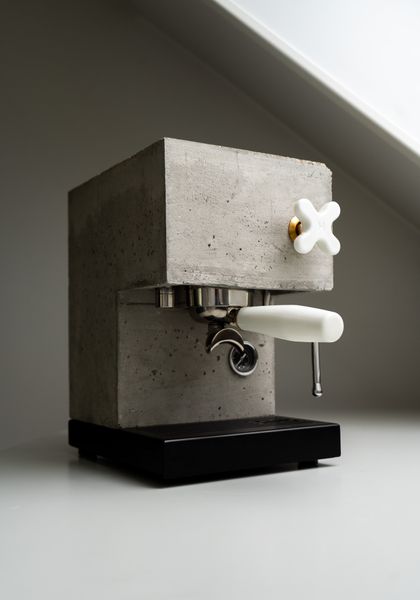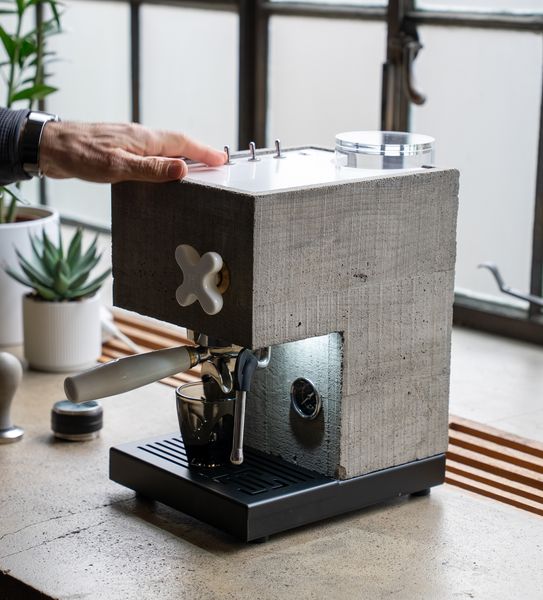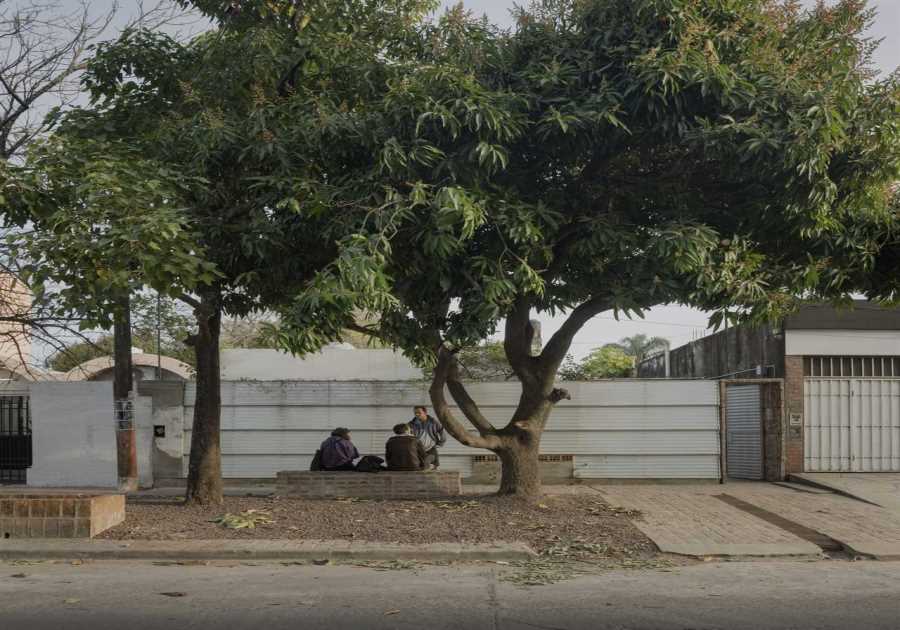Anza’s rerelease of a no-frills concrete espresso machine is only the latest fetishization of one of architecture’s most severe styles.
When Le Corbusier was building the famous L’Unité d’Habitation housing complex in Marseille, France, coffee was one of the only ways he could have had caffeine; Coca-Cola had only just shown up in the country as the development was being finished in 1952. Partway through its construction, in 1949, photographer Will Rizzo actually captured the Swiss-born urbanist preparing a black cup. And when Marcel Breuer arrived in New York City in 1946, America was drinking twice the amount of coffee it does now. It wouldn’t be a stretch to guess the renowned architect partook, and if he did, to imagine he stuck with the ritual at least up until designing the Breuer Building in New York in 1966.
One could surmise that brutalism was born on a coffee high. But what does coffee know about brutalism, exactly? Searching for "brutalist coffee shop" on Pinterest shows that corners of global café culture have adopted the architecture style’s devastatingly spartan aesthetic time and again, echoing the no-frills tenor of the beverage itself. On the surface, these shops share brutalism’s forefathers’ wholesale rejection of nostalgia, frivolity, or embellishment. A building’s form speaks for itself, and—bear with me—so does a ristretto and any cortado or flat white it belongs to.
Without plumbing the depths of third-wave coffee’s knowledge of Breuer or Corbusier, safe to say, the culture has a fetish for the austere, which extends beyond stripped-bare warehouses in freshly gentrified parts of town and board-formed coffee counters in financial districts. At-home devices aimed at fans of both brutalism and espresso are seeing a surge, too. At the end of 2024, Brazilian company Bruta released a countertop device that lets you pull shots by hand—its concrete base and metal lever are about as bare bones as making espresso gets—and now, Anza, which released a concrete-shelled machine in 2017, is back with a second, updated version.
The culture is clearly primed for a redux. Last year, A24 gave concrete architecture the pop culture treatment with The Brutalist, and followed it this year with the documentary Architecton, a meditation on what stone and concrete structures reveal about society—brutalism is on the collective brain. But according to the designer of the Anza machine, Andrew Smith, bringing a solemn reverence for brutalism to your kitchen counter was never the point. Instead, he sought an alternative to the market’s "generic stainless-steel boxes," a trend he became privy to while sharing a commercial space in Berkeley, California, with a repair person. "People really enjoy making espresso at home, but these machines weren’t contributing to that experience," Smith tells me over a video call. "When you see how dominant these things are in your wonderful designer kitchen, it’s like, isn’t there something missing here?"
There is an obvious reason for all that loud, shiny metal—it’s easy to wipe away splattered espresso and milk. Still, Smith couldn’t help but run in the opposite direction. "We thought, wouldn’t it be funny to use some sort of nonintuitive material? Concrete was the obvious thing. It was the opposite of shiny and polished and made by a machine"—the opposite of the type of thing a certain kind of coffee bro nerds out over, he says. Opposite of something La Marzocco might do. "It was going to be handmade and rough and a bit gritty."
The Breuer Building, with its top-heavy massing, doesn’t give one the sense that its architect was winking or nodding when he created it. Its shape, and how Breuer arrived at it, however, fatefully overlap with that of the Anza machine. With the museum, a recess carves out space for an entrance with a basement-level patio below; for the Anza, a similar cutout makes room for the portafilter, steaming wand, and a tray that catches hot water. (The Breuer Building did have a cafe of its own, brutalist in character perhaps only by nature of being inside this building, which closed after the property’s recent ownership change.) "It looks like a mini building in many ways," says Smith of the machine. "The concrete and its shape immediately starts talking the language of brutalism. You kind of can’t avoid it."

The Breuer Building in New York City has a top-heavy massing not dissimilar from the Anza espresso machine.
Photo by Christina Horsten/picture alliance via Getty Images

The espresso maker has a concrete shell cast by hand, making each one slightly different than the next.
Courtesy of Anza
If the espresso maker’s inevitable merging with brutalism is meant partly as a joke, I get it. I am, in ways, exactly who it’s for. My household has an unwritten but often-talked-about no-appliances-on-the-counter rule, which mostly comes back to whether or not we should buy an air fryer. (We don’t own one). The edict is meant to minimize clutter on our limited counter space, which means a steel-wrapped box grotesquely decorated with steam punk gadgetry—gauges, wands, knobs, levers—is out of the question. The Anza is surprisingly quiet by comparison, giving a sly wink to brutalism on our kitchen counters where it joins an unfunny blender, an electric kettle, a fruit bowl, a dish drying rack, and a cutting board.
In another way, the Anza functionally offers everything a no-talent barista like me needs. As someone whose restaurant job out of college gave him the equivalent of a burger flipper’s education on an espresso machine, I am only so qualified to provide an assessment of its technical prowess, but the R2’s upgrades seem nice: A removable water reservoir (straightforward enough), a pressure adjustment screw (getting nerdier), a pre-infusion option (lets you "bloom" the grounds, like a pour over—still with me?), and a steam wand that’s somewhat insulated so you don’t totally scorch yourself while foaming milk (a safety feature we all need and understand).

Three switches atop the unit provide streamlined functionality: one to pour hot water (handy for topping up an Americano or cleaning the portafilter), another to pull an espresso shot, and a third to activate the steaming wand.
Photo by Kokie Padilla
See the full story on Dwell.com: What Does Coffee Have to Do With Brutalism Anyway?
Related stories:
- The Best of Pacific Northwest Design Took Center Stage at the Seattle Art Fair
- Chicago Is Experimenting With a Solution to Depopulation: New Housing on City-Owned Land
- "Freedom Cities" Won’t Solve the Housing Crisis
Read More
By: Duncan Nielsen
Title: What Does Coffee Have to Do With Brutalism Anyway?
Sourced From: www.dwell.com/article/coffee-and-brutalism-anza-r2-espresso-machine-rerelease-b6df1520
Published Date: Tue, 19 Aug 2025 16:52:07 GMT
.png)





